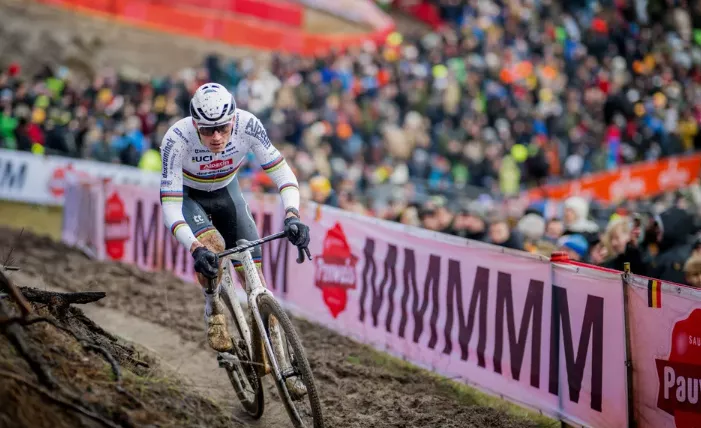Mathieu van der Poel’s unexpected domination in cyclocross raises questions about the sport’s competitiveness and future.
Mathieu van der Poel’s return to cyclocross has made an immediate impact. After skipping the early part of the season, the Dutch world champion turned up for his first race of the year at the Zonhoven World Cup on Sunday, and—despite his own admission that he wasn’t pushing hard—won by over a minute. His victory, followed by another at Mol in the Superprestige series on Monday, has reignited interest in the sport. But as the sport struggles to capture the imagination of casual fans, van der Poel’s effortless triumphs raise questions: Is his dominance in races “in zone 2” good for cyclocross?
In a post-race interview, Van der Poel stated, “Yes, it was a great victory today, but I preferred to save myself and stay in zone two throughout the race. I plan to do some high-intensity training this week.” The 28-year-old champion’s nonchalant tone was striking—he wasn’t racing to win, but simply keeping himself in a comfortable effort zone. It’s hard to imagine anyone else in the field holding back in such a way and still managing to dominate.
While his victories are undoubtedly impressive, they come at a time when the World Cup series is lacking the star power of its two biggest names. Van der Poel’s archrival, Wout van Aert, has also been absent from many events, leaving the door open for lesser-known riders like Eli Iserbyt, Michael Vanthourenhout, and Niels Vandeputte to claim World Cup wins. In fact, Iserbyt currently leads the X2O series, and Lars van der Haar tops the Superprestige rankings.
However, the lack of a consistent challenge from Van der Poel and Van Aert has made the season feel anticlimactic for many fans. When they do choose to race, these two riders—along with Great Britain’s Tom Pidcock—are simply in a different league. Van der Poel has claimed six World Championships over the past nine years and aims for a seventh title this February. His dominance in the sport is clear, but it raises a crucial question: Is this good for cyclocross?
The simple answer is that Van der Poel and Van Aert’s presence boosts the sport’s visibility. Their participation draws larger crowds and garners more television attention, benefiting the sport in the short term. However, this “star power” also highlights a larger issue: the sport seems increasingly polarized between the top-tier riders and the rest of the field. The gap is so wide that even riders like Tom Pidcock, the only other cyclist to win a World Championships in recent years, seem a rung below. The result is that when Van der Poel or Van Aert are racing, the competition is often decided before the final lap.
One factor in their dominance is the intense road racing calendar that both riders follow. Van der Poel, for example, has his eyes firmly set on the spring classics and grand tours, and it’s likely this road program that makes him so formidable in cyclocross. His father, Adrie van der Poel, a former cyclocross world champion himself, recently explained: “The difference is that those guys ride such a tough road program. You can see it uphill—they can ride one or two gears higher and just ride away from the rest.” This road training, combined with their inherent talent, seems to give them a significant advantage over the competition.
But it’s not just road racing that sets them apart. Both Van Aert and Van der Poel were dominating cyclocross long before they became road racing stars. This raises the question: What does this mean for the future of the sport? As it stands, the dominance of multi-discipline riders—those who excel in both road racing and cyclocross—has created a scenario where true cyclocross specialists struggle to compete at the highest level.
Cyclocross has become a sport of “elite” riders, with little room for surprises. While the presence of Van der Poel, Van Aert, and Pidcock undoubtedly elevates the sport’s profile, it also raises doubts about whether the racing would be more exciting with closer competition. The absence of these riders from many events this season has led to a surge in new talent at the top, but it also highlights how dependent the sport has become on these few individuals.
The situation is further complicated by the growing pressure on these riders to excel in their primary road cycling roles. With increasing sponsor and media attention, it’s no surprise that Van der Poel and Van Aert choose to focus more on road races during the offseason. As a result, cyclocross is left to suffer—at least until the “big three” riders choose to return to the mud and sand.
The sport is at a crossroads. While the headline-grabbing performances of Van der Poel and Van Aert certainly provide a boost to the sport’s popularity, there is a risk that their sporadic participation creates an uneven playing field. Cyclocross needs a solution to maintain excitement and competition, but finding that balance is easi
Related topics
- Pogačar Breaks Strava KOM on Coll de Rates
- Lael Wilcox’s Next Challenge: The Iditarod Trail
- Hannah Roberts Wins Fifth Straight BMX Freestyle World Title

